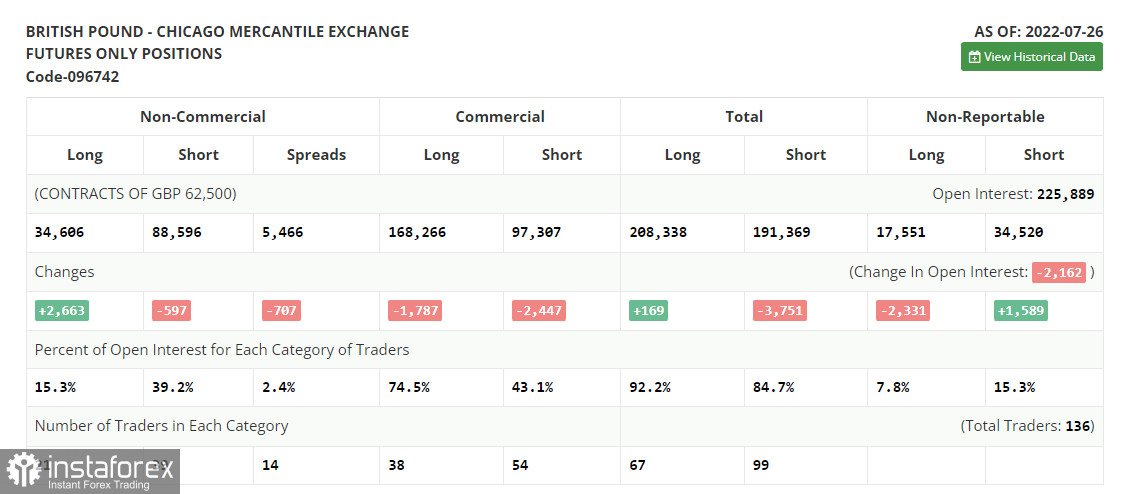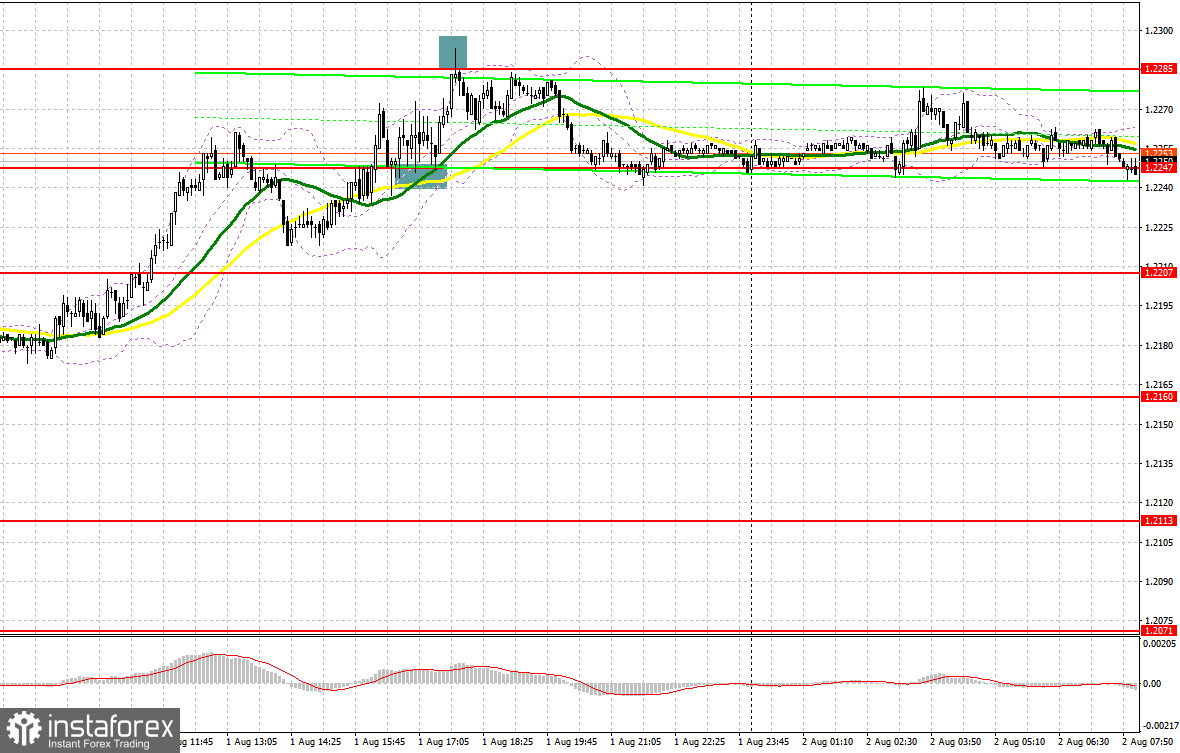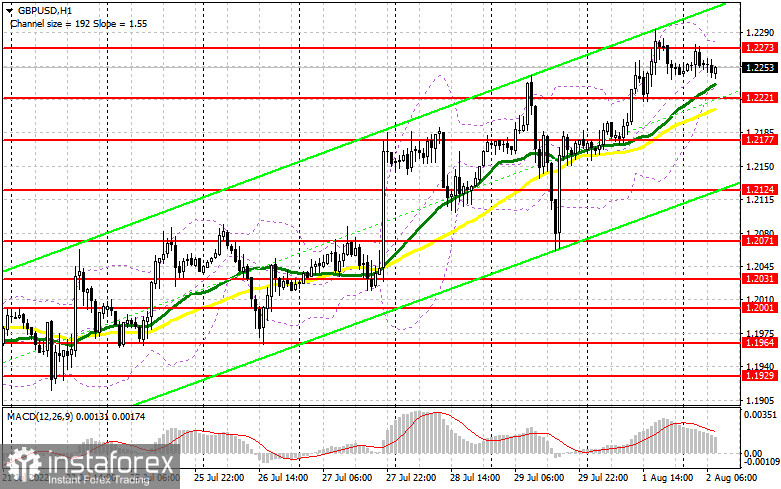Conditions for opening long positions on GBP/USD:Yesterday, traders received several good signals to enter the market. Let us take a look at the 5-minute chart to clear up the market situation. Earlier, I asked you to pay attention to the level of 1.2247 to decide when to enter the market. An unsuccessful breakout of this range in the first part of the day led to a buy signal, thus pushing the pound sterling to the nearest resistance level of 1.2285. As a result, traders received about 40 pips. Just after the pair tested 1.2285, sellers became more active. A false breakout of this range gave a sell signal, allowing traders to earn another 40 pips.

Let us focus on the futures market before we start analyzing the British pound from the technical point of view. According to the COT report from July 26, the number of short positions dropped, whereas the number of long positions surged, reflecting the current market situation. The British pound is in demand. What is more, there is no doubt that the BoE will continue raising the benchmark rate this month. The regulator's aggressive policy has been having a positive influence on the national currency despite some economic problems. Last week, the US Fed decided to hike the key interest rate to combat surging inflation. This action is likely to affect the BoE's decision. Notably, demand for the pound sterling is not as high as it might seem. The pound/dollar pair is gaining in value amid the falling greenback. The fact is that there are rumors that the Fed may loosen its monetary policy this autumn. Even amid this backdrop, the pound sterling is unlikely to go on rising due to the cost of living crisis and economic slowdown. The COT report unveiled that the number of long non-commercial positions increased by 2,663 to 34,606, whereas the number of short non-commercial positions declined by 597 to 88,596. As a result, the negative value of the non-commercial net position decreased to 53,990 from -57,250. The weekly closing price rose to 1.2043 against 1.2013.

Today, the UK is not going to disclose any important reports. The Nationwide house price index data will hardly affect the market amid the current bullish trend. Today, bulls should primarily protect the nearest support level of 1.2221, which was formed yesterday. There, we can see bullish moving averages. If the pair drops, traders should wait for a false breakout of this area to receive a buy signal, which may boost the pound sterling. The nearest resistance level of 1.2273 will act as the target. Yesterday, buyers hit this level, but failed to break it even during today's Asian trade. Only consolidation above this level and a downward test will give a buy signal with the target at 1.2329. At this level, buyers may take a pause. The next target is located at 1.2393, where it is recommended to lock in profits. However, traders should remember about the upcoming BoE meeting. The pair's upward potential will be limited. If the pound sterling declines during the European session and bulls fail to be active at 1.2221, it will be better to avoid buy orders until the price hits the next support level of 1.2177. A false breakout of this level may give a long signal with the target at the lower limit of the upward channel. It is also possible to buy the asset just after a bounce off 1.2124 or lower – from 1.2071, expecting a correction of 30-35 pips.
Conditions for opening short positions on GBP/USD:
It will be better to go short after a false breakout of the new resistance level of 1.2273. The pair has tested this level twice in the last 24 hours. That is why only unsuccessful consolidation above 1.2329 will give a sell signal with a target at the support level of 1.2221. Under the current conditions, a lot depends on this level. A breakout and an upward test of this level may push the pound/dollar pair to the low of 1.2177. In this case, the pair may return to 1.2124. The next target is located at 1.2071. If the pair tests this level, the bullish trend, which began on July 14, is likely to end. If the pair increases during the European session and sellers fail to protect 1.2273, bears will lose their chance to regain control over the market. In this case, traders should avoid short orders until the pair hits 1.2329. There, it will be wise to sell the asset after a false breakout. It is also possible to go short after a rebound from the high of 1.2393 or higher – from 1.2452, expecting a decline of 30-35 pips within the day.

Moving Averages
Trading is performed above 30- and 50-day moving averages, which points to an attempt to continue the rally.
Note: The period and prices of moving averages are considered by the author on the one-hour chart that differs from the general definition of the classic daily moving averages on the daily chart.
Bollinger BandsA breakout of the lower limit of the indicator located at 1.2221 will intensify pressure on the pair. If the pair increases, the resistance level will be located at 1.2275, the upper limit of the indicator.
Description of indicators- Moving average (moving average, determines the current trend by smoothing volatility and noise). The period is 50. It is marked in yellow on the chart.
- Moving average (moving average, determines the current trend by smoothing volatility and noise). The period is 30. It is marked in green on the graph.
- MACD indicator (Moving Average Convergence/Divergence - convergence/divergence of moving averages). A fast EMA period is 12. A slow EMA period is 26. The SMA period is 9.
- Bollinger Bands. The period is 20.
- Non-profit speculative traders are individual traders, hedge funds, and large institutions that use the futures market for speculative purposes and meet certain requirements.
- Long non-commercial positions are a total number of long positions opened by non-commercial traders.
- Short non-commercial positions are a total number of short positions opened by non-commercial traders.
- The total non-commercial net position is a difference in the number of short and long positions opened by non-commercial traders.





















